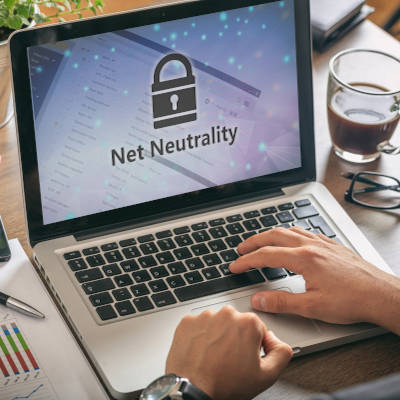Download the Business Owner's Cybersecurity Blueprint

100% Free & Secure - We will never sell your information.

The COVID-19 outbreak has been a trying time for businesses and individuals, alike. Not much positive has come from it, as people, who typically band together in times of unease, are asked to stay away from each other. This has led to many people turning to their smartphones and Internet connections to communicate with the people they hold dear. With a national reliance on Internet connections there have been some new voices (and some familiar ones) advocating for the return of net neutrality. Today, we’ll remind you what net neutrality is and why this situation has people calling for a change.
Net neutrality is the act of having an open Internet that is overseen by the public to ensure that all the people that need to get reliable internet access, can. The Internet Service Providers (ISPs) argue that because they own most of the infrastructure that it should be them who sets the rules over what type of Internet service is for sale and how to provide the bandwidth for individuals and companies. This obviously sets them at odds.
One of the best analogies used to describe net neutrality is that of the “dumb pipe’ in a city’s water system. In this scenario all people hooked onto the system would get an equal amount of water pressure. Their individual identity or specific use for the water isn’t factored in. This is why some of the most public organizations are in support of this policy. Human rights groups, civil rights groups, animal rights groups, and consumer advocacy companies all support net neutrality.
ISPs and the major telecom companies like Verizon and AT&T have a lot to lose if they lose the power to determine how to disseminate their product. This, and how it has played out in the political sphere, make this an absolutely fascinating issue.
With the COVID-19 outbreak affecting most people–and organizations like the Centers for Disease Control and Prevention and many state’s Governments have suggested a stay-in-place policy–connectivity is looked on as essential. It has led the Federal Communications Commission, the same entity that worked to privatize Internet connections, to reach out to the ISPs and telecoms with the establishment of the Keep Americans Connected Pledge.
Here is the press release sent by the FCC on March 13, 2020:
“Given the coronavirus pandemic and its impact on American society, [[Company Name]] pledges for the next 60 days to:
(1) not terminate service to any residential or small business customers because of their inability to pay their bills due to the disruptions caused by the coronavirus pandemic;
(2) waive any late fees that any residential or small business customers incur because of their economic circumstances related to the coronavirus pandemic; and
(3) open its Wi-Fi hotspots to any American who needs them.”
With the seriousness of the situation, dozens of ISPs have signed, many of which during the first hours; and, many of them have gone beyond the pledge to help society deal with the COVID-19 pandemic by eliminating data caps and taking other actions. In a statement, FCC Chairman Ajit Pai said:
“As the coronavirus outbreak spreads and causes a series of disruptions to the economic, educational, medical, and civic life of our country, it is imperative that Americans stay connected. Broadband will enable them to communicate with their loved ones and doctors, telework, ensure their children can engage in remote learning, and — importantly — take part in the ‘social distancing’ that will be so critical to limiting the spread of this novel coronavirus.”
This has led many people to wonder why, if the Internet is being treated like a utility, why it is being regulated as a private service? The calls for net neutrality, despite the admittedly generous stance of ISPs, is sure to get a fair amount of attention when the COVID-19 mess is over. One thing is for sure, people today need access to high-speed Internet more than ever before.
How do you feel about how the ISPs have handled this situation? Leave your thoughts in the comments below and check back at our blog for more information about technology.
Author’s recent posts
